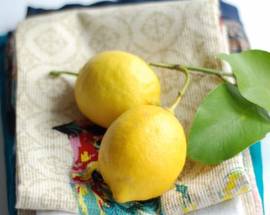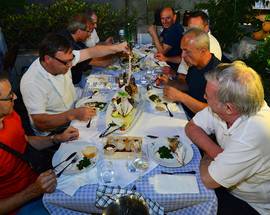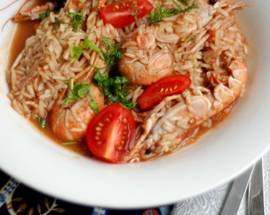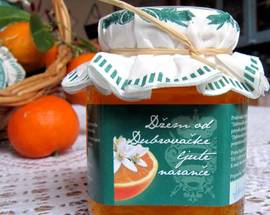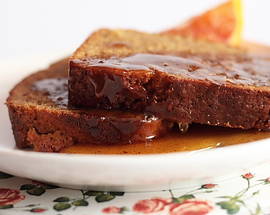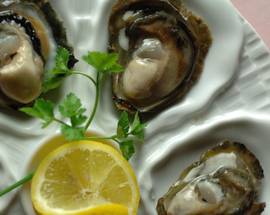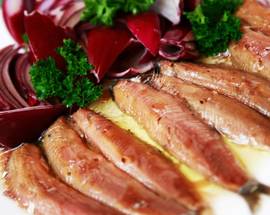Homemade makes for the best flavour of all! In this section, you will find the pure essence of gastronomy specific to the region, from age-old recipes prepared during the era of Kings and noble families to ordinary dishes that the Nona’s cook best. And for the icing on the cake, we also give you a list of culinary events full of fragrances, colours and flavours that will enchant on your visit.
Jump to:
- Local Dishes
- Local recipes
- Pelješac Wines
- 10 Gifts For Hungry Loved Ones
- Become a wine connoisseur
- Chef's Interviews
Local Dishes
Despite Dubrovnik having centuries-old trading connections across the globe, the cuisine of this region is very much based on the gifts of nature in this part of the world. Classic Dubrovnik cuisine is seasoned with parsley, garlic, olive oil and lemon, and perhaps a touch of rosemary or bay leaf if the chef is on the adventurous side. A true Mediterranean experience, you might say.
This tendency to eschew more exotic ingredients can be a double-edged sword. On the one hand, the city’s menus can seem somewhat repetitive. On the other hand, what you eat is fresh, natural and, in the better restaurants, local. The simplicity of the preparation lets the flavours of high quality ingredients do the work. It’s hard to beat a good piece of meat or fish grilled over charcoal with a salad freshly picked from a hinterland garden.
In defence of simple cooking, experiments with “imaginative” cuisine can be like playing Russian roulette. In anything but the most skilled hands and pedantic husbandry the result can be disappointing. For example, in Provence, as Financial Times food columnist Rowley Leigh complained bitterly in summer 2012, it’s hard find an authentic bouillabaisse or ratatouille these days. Peasant food gains elevated status and loses its guts. Croatian food is still unfashionably plentiful and full of flavour, and all the better for it.
So, what can you eat in Dubrovnik if you’d like to escape the grilled fish – grilled meat – pasta trinity? The best answer is the same as anywhere: the same as the local people eat at home.
Let’s start with the basics. Šporke makarule is the local version of everyone’s favourite: spaghetti bolognese. However, with hand-made pasta, small chunks of beef (not mince) and fresh tomatoes, it becomes something special. You’ll see big vats of the stuff served on the street at Carnival time in February. But even on the hottest day, add a crisp green salad and you’ve the perfect lunch.
A more special dish served throughout Dalmatia is pašticada. There are many variations, but generally a lean piece of beef is studded with carrot, garlic and smoked bacon and marinated in wine, oil, vinegar with perhaps a little orange and lemon. It’s cooked in a rich sauce, sometimes with prunes, and served with soft gnocci.
A winter warmer that truly displays the spirit of the region is konavoska zelena menestra. A selection of cured meats (pork, mutton, sausage) is cooked up with winter greens and potato. When finished, the meat is served on a plate and the smokily scented veg dished up with a little of the soupy liquid and lashings of olive oil. This dish dates from the 16th century; for added historical effect substitute barley for potato. Fast forward to springtime when broad beans are ready for picking: try them cooked with smoked mutton, garlic, parsley and bacon fat.
To get a little more exotic, consider an excursion northwards to the Pelješac peninsula, where you can treat yourself to Ostrea edulis, otherwise known as the finest oysters in the world, prepared in a million different ways. While you’re there, look out also for butarga (dried flathead mullet roe); there are a couple of families here who still prepare this rare delicacy.
Further north still, the Neretva river estuary is home to all kinds of aquatic life and a magnet for culinary adventurers. Fancy a plateful of snails cooked over an open fire? Eel cooked in a rich brudet sauce? Frog risotto, perhaps? It’s the perfect end to a watery day’s safari.
To accompany your traditional-style meal you’ll want a drop of the local grape. Where reds are concerned it’s easy. The Pelješac peninsula is the home of some of the most prized wines in Croatia: Dingač and Postup. Redolent of the sun that warms the rocky vineyards, they’re high in flavour and alcohol and a little bit pricey. Their cheaper younger brother, Plavac pelješki, is a palatable alternative. For whites, look out for Dubrovnik Malvasia (not the same thing as Istrian Malvazija). It might be white but it’s pretty intense so can go with meats as well as fish.
And to finish off, you’ll see rožata on many a menu: it’s the local version of crème caramel. Not so frequently spotted is stonska torta made with cooked macaroni. We think there’s no better way than to finish your meal than some fragrant figs (fresh in season, dried at other times), a handful of almonds and a liquer made from oranges, mandarins or rose petals.
Local recipes
Orancini
Peel an orange, preferably unwaxed, organically grown (you don’t want pesticides on the skin). Cut the peel into strips about 3-5cm long and 0.5cm wide. Pop the peel into a dish and cover with water. Leave to stand for two days. Put the strips and water in a pan, bring to the boil then drain off the water. Add sugar in an amount equal to the weight of the orange strips. Stir in the pan with just a drop of water until the water evaporates. Again, leave to drain, then roll the strips in sugar. Leave to dry.
Bruštulane mjendule
Sugared almonds to you and me. Weigh out some almonds, pop them in a pan with an equal amount of sugar. For every 50g of almonds add a dessert spoon of water. Warm the pan on a medium heat, constantly stirring until all the sugar melts, then solidifies and sticks to the almonds. Shake onto a plate and leave to cool before attacking.
Kotonjata
From Dubrovnik in the south, it's a strongly flavoured dessert that looks like a jelly. No friends, it's not a jelly at all but is instead the wiggly product of a sweet and bitter fruit called dunja. Wise old grandmas often place a number of these yellow guys all around the house to ward off the raunchier stenches that can build up from time to time.
Mantala
A purple - coloured cake served with sweet black syrup, almonds and cinnamon.
Pelješac Wines
Those who do not know much about Croatia can be forgiven for not realising that wine is as much a part of life here as it is Italy, a country which sits on the opposite side of the Adriatic Sea. In fact, wine has been a part of this region since the days of the Ancient Greeks, who had settled parts of Dalmatia in the 5th century BC, including the islands of Hvar, Vis, and Korčula (birth place to Marco Polo). In time, the Roman Empire expanded into Dalmatia – then peopled by the Illyrians - bringing with it more modernised methods of cultivation, and under Roman rule Dalmatian wine saw itself being exported to other parts of the Mediterranean, and beyond. Eventually the Croats would come to live here, and they saw fit to further expand the region’s wine production. Croatian wines would be welcome at the Austrian and Hungarian courts, and with many a farmer relying on his own vines to keep him in wine then you could be assured that quality levels were kept quite high.
The country’s history being what it is it’s perhaps not such a surprise to discover that some of the wineries are not so well known, even nationally, but it won’t be long before all of that will change. Here, we’ll look some of the more tempting local wines.
Plavac Mali, or Little Blue, is a variety of red grape closely related to Zinfandel and Primitivo. It is grown almost exclusively on the western side of the island of Hvar and the Pelješac peninsula. The wine it produces tends towards a deep purple-red colour, high in tannins, extract, and alcohol. Normally presenting a rich, dry taste, the better vintages will be more mild and sweet. Those who know such things recommend that such reds be enjoyed with red meat dishes, black olives, and salted anchovies. Dingač is a variety of Plavac Mali and is considered by many to be the Holy Grail of local wines, and can only be grown in this region as a result of very specific geographical conditions. Such is its importance to Dalmatia that in 1961 it fell under the protection of the Geneva Convention, the first Croatian wine to do so. It is of a deep ruby red colour, of an exceptionally unique and luxurious bouquet, a nicely accentuated aroma, and a harmonious fullness of taste. Dingač was joined in 1967 by Postup, a top-quality red wine created from the grapes of the Plavac Mali variety, exclusively from the location of Postup, which is on the southern slopes of the Pelješac peninsula. Postup is a darker red, with a full, harmonious taste with a touch of crispness.
Now, while it’s true that Dalmatians prefer red wine to white (the opposite would be the case in Croatia overall), there are more than a few high quality whites available. Rukatac, however, is the gleaming jewel in Dalmatia’s crown. An endangered grape to be sure, it is indigenous to the peninsula. It can be found from Prevlaka to the Croatian coast, and again on the islands of Korčula and Lastovo. Wines made from rukatac are ideal for dessert wines, known as prošek. It is often greenish to golden colour with an extremely pleasant bouquet. Like most other whites, this is best while it is still young to drink during the first or possibly second year.
There are other producers on the peninsula of course, and it would be remiss to neglect names such as Korta Katarina, Skaramuča, Madirazza, Matuško, to list but a few. The area’s wineries are generally inclined towards a wholly welcoming atmosphere, with Udruga pelješki vinski puti (Association of Pelješac Wine Trails) and Plavac mali being just two associations which put considerable effort into ensuring grape quality and the promotion of the peninsula’s wine growers and wine trails.
Detailing any one of the many wine trails would take too much time and too many print inches. Needless to say that any tourist may put their fate in the hands of a seasoned local or tour guide and take advice from them – or put the effort in and plan your own tour of this Croatian exclave. More than a few tour operators will bring buses and boats onto the peninsula from Split and Trogir, and if you’re time is flexible enough then it’s well worth taking the day to get as many wineries and vineyards in as possible. Make sure you find yourself near Ston, because you’ll want to sample the oysters as well as the wine.
WINE TRAILS & GASTRO TOURISM
Wine trails, or roads, are an important economic tool for any region such as the Pelješac peninsula. When you’re not only removed from the centre of the continent but from your own country too, you must do all in your power to ensure that your tourism sector is doing its best to attract – and keep – as many visitors as possible.
Wine trails are not a new concept as well worn roads emerged over centuries of use as producers moved their wine to market. The more worn the road the more popular – it’s reasonable to assume – the wines which are produced within its vineyards. Alongside these wine trails a healthy gastro-tourism sector is developing; after all, you do need to eat if you’re going to be drinking several glasses of wine over the course of a day. With Dalmatia offering a variety of local and Mediterranean, you’re never likely to try the same dish twice even if you’re dining out each night of a holiday.
- Edivo Wine Bar
- Grgić Vina
- Skaramuča wineshop and wine bar
- Vinarija Korta Katarina
- Vinarija Miloš
- Wine shop&bar Peninsula
10 Gifts For Hungry Loved Ones
One of the pleasures of Croatia is natural, tasty food. So what better gift for those back home1. Ground Wild Fennel
The rocky plains of Dalmatia are covered in the grey stems and yellow blooms of wild fennel. Mrs Marica Marasović from the island of Vis sells dried and ground fennel for flavouring soups, salads, stews and dressings. Contact (+385) 91 588 84 09, marica.marasovic@gmail.com.
2. Grisini
A tasty twist on Italian grissini, these ones from the island of Silba are enriched with pumpkin, sunflower and sesame seeds, with chilli, caraway, truffle or anchovy. Perfect with a nice cold beer or cocktail. Pick them up in Zadar from Ivan Motušić, tel. (+385) 99 771 69 98.
3. Olive Leaf Tea
Olive leaf tea is believed to be rich in antioxidants, thus supporting a healthy heart and immune system. It's a traditional drink from the Croatian islands which you can pick up in Paška sirana cheese shops around the country or on the island of Pag in Vrtovi Lunjskih maslina, Lunj. Open Mon - Fri 08:00 - 15:00.
4. Koludrica Cake from Rab
“Rapska torta” or Rab Cake is a concoction of marzipan wrapped in delicate pastry traditionally reserved for feasts such as weddings. The version made by the Benedictine numbs at St Andrew's Convent in Rab was first made for the visit of Pope Alexander III in 1177 and features
their own Rosolio liqueur. Call in to the convent at Ivana Rabljana 6, Rab Mon - Sun 09:00 - 12:30, tel. (+385-51) 72 42 32.
5. The Captain's Cookies
Unique almond cookies have been made for centuries on the Peljesac peninsula, baked to see off sea captains on their voyages. You can pick up a gift-wrapped package at the Croccantino cake shop at Obala pomoraca 30, Orebić (Open 07:00 - 24:00), and in local Antunović bakeries.Contact: mantunovic87@gmail.com, tel. (+385-) 98 165 07 77 Marija Antunović.
6. Pag and Brač Island Cheese
Pag island is synonymous with good cheese in Croatia, with two factories supplying great cheese to the whole country. Look out for the Paška sirarna and Gligora brands.
Brač island cheese is exclusively sold locally. It's not easy to get hold of a round of cheese as it’s a natural seasonal product made in small quantities. But it is well worth the effort. Try the Kuzmanić family, Put Varoša 18, Supetar, Brač, aktiva.brac@gmail.com, tel. (+385-21) 63 04 98, (+385-) 91 594 52 79.
7. Lumblija
Lumblija is a sweet from Korčula island made from wine must, olive oil, almonds, dried fruit and spices. It was apparently the recipe of a French soldier who presented a cake to his island beloved on his departure with the words “n'oubliez” (“don't forget!”). This was Croatianised as
“lumblija”, and the recipe has lived on ever since. You can order a cake from Mrs Vlašić, Obala 2, Vela Luka, Korčula, iskravlasich@gmail.com, tel. (+385-) 98 182 84 07.
8. Krk Island Pršut
To make great cured ham you need a brisk north wind laced with plenty of salt and herbs, which is why generations of Krk islanders have prepared their own pršut. This is a product that varies depending on the environment and the recipe, so it's different wherever you go. Try Krk pršut at the Žužić butcher's shop, Zagrebačka bb, Krk, tel. (+385-51) 22 21 38 (Open Jun/Sep 07:00 - 20:00, Jul-Aug 07:00 - 21:00) or at Kuća krčkog pršuta at Bok od Brozića 40, Vrh, Krk, tel. (+385-51) 68 60 98 (Open Jun/Sep 12:00 - 22:00, Jul-Aug 12:00 - 23:00).
9. Salt Petals
Real foodies, these days choose from a selection of salts as they cook. A new one to try is cvijet soli (fleur de sel) from Nin's Roman salt pans. Fleur de sel is made of soft, moist flakes harvested, gently from the water's surface. Delicious sprinkled on fine foods, the crystals are rich in minerals and created in an ecologically pristine environment. Pick up a box in at the Solane Nin museum shop, Ilirska cesta 7, Nin, tel. (+385-23) 26 40 21 (Open 07:00 - 20:00) or selected shops nationwide. www.solananin.hr
10. Macaroni Needles
One of the best comfort foods from the Croatian island cuisine is goulash served with homemade pasta such as makaruni na iglu, pasta wrapped around a skewer to produce an slender tube. Pick up some in the Mahulja bakery, Gundulićeva 4, Novalja, Pag Island (Open 06:00 - 12:00),tel. (+385-53) 66 36 57, or during the summer at mobile bakeries in Novalja, Mandra and Stara Novalja (Open 07:00 - 19:00).
Become a wine connoisseur
A sommelier Jelena’s recommendations of which wines to tickle your taste buds!Winemaker Crvik, Konavle: Dubrovnik’s Malvasia Tezoro
A white wine, dry, mineral, fruity and full-bodied. A fantastic white from the Dubrovnik region and thanks to its rich character, it nicely complements food.
Andro Crvik, winemaker: Pomet Plavac mali selection
A great Plavac and highly recommended. Extremely fruity on the nose, shades of smoke and prunes emphasised. Complex, medium to strong in body, beautifully fresh and soft. Maintains a long lasting finish and has great potential for aging.
Dubrovački podrumi, Gruda: Dubrovački podrumi Plausus
Plausus is a premium wine from Plavac mali, it is of exquisite elegance and fullness. Recognisable by the variety of aromas. Intense in flavour, nicely balanced, strong body and a rich long finish. A wine which demands powerful food. It’s a top quality indigenous wine and the most important red grape sort in Croatia.
Skaramuča, Pelješac
Dingač Skaramuča, top quality wine, medium-bodied, aged in wood, nicely rounded, extremely rich and fruity. Finely acidic and expressively harmonious. A strong and mature wine tendered well with venison or ham.
Jako vino, Brač: Stina Pošip Majstor
A white wine with a fuller body, exquisitely fruity in aroma. Very nice, well-balanced and kept in wooden barrels. An extract wine of exceptional elegance and a fine addition in general and in particular with seafood.
Tomić Bastijana, Hvar: Belec, Pošip & Bogdanuša
A white wine in the blend of indigenous variety, very lovable to those with an aroma for flora. Very light thus fit for daily consummation. Mineral, slightly acidic and light in body. A great summer refreshment.


